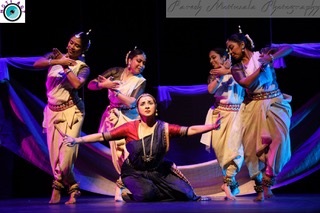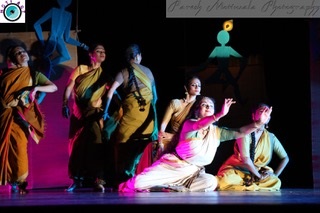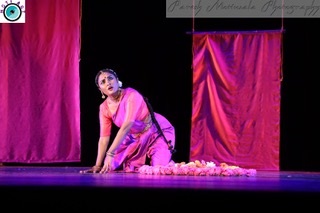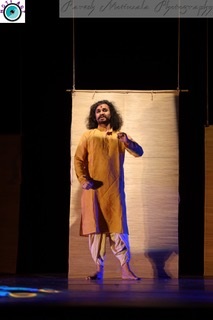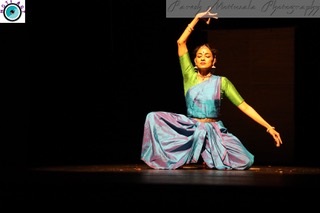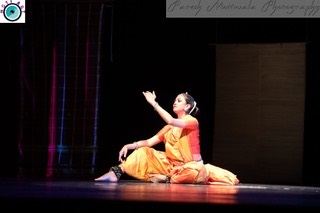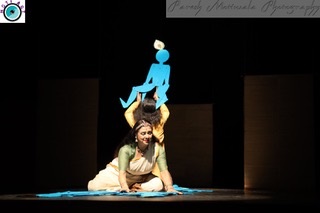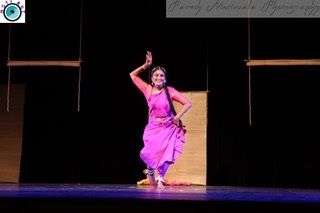Contribute
| Antaryatra: A Conversation Towards Self-discovery |
Pallavi Nagesha
09/27/2019
~Yoga Darshana Upanishad All art is introspective. A dialog between the artist and the ever-present observer, the sÄkṣī. When you are able to have an intimate conversation, only then will you have something worth sharing and something that another is interested to listen to. A conversation that a sahá¹›dayÄ will participate in. Every performer strives to create that intimacy. That level of “similar heart†that pulls the connoisseur in and leaves all breathless and drumming with reverberations of the encounter. On September 22nd, Sharmila Biswas and her troupe of artists took the audience at Regis College, Weston, MA on just such an introspective journey, an AntaryÄtra. The 7th annual donor appreciation event of the AIM for Seva organization once again brought to the New England Rasikas a performance filled with the message of joy and giving. In a multimedia extravaganza, the ensemble dancers performing Bharatanatyam, Kuchipudi, and Odissi brought to life in vivid color, the internal pilgrimage of a dancer. Presented as a dialog between the dancer and the Rasika, Sharmila Biswas conceived an abstract journey that takes you on a path with glimpses of bliss. The destination is fulfillment, but to each purveyor, that place is distinct and private. So, imagine going along with so many like-minded folk (sahá¹›dayÄ) but reaching your own idyllic private island. AntaryÄtra sought to take us on just such a journey. Sharmila described the three images of the dancers as an extension of herself as she vacillates between the mundane and the spiritual, seeking the beloved. Beginning with the “song of the heart†the three dancers take turns portraying three dimensions of this quest. It is said that to uncover your demons and your angels, you first need to reach in and churn. The ensemble dancers recreated the biggest churn that brought to existence the entire universe, the sÄgara manthanaṃ, the churning of the ocean of milk. From this churning emerge apsaras, nymphs who represent the different arts. Creative, volatile and impulsive, they are held together by a thread almost as if they reside within each of us and these invisible links are holding these beings within us. From this idea arises the notion of the performer, the naá¹a. Grasping at this tread. The narrator, portrayed by Sharmila Biswas herself, begins the journey taking us through her alter egos, surcharges to her own energy. It opens with Sreelakshmy Govardhan rendering an ingénue in the Kuchipudi style. Filled with exuberance and a healthy sprinkling of self-doubt, she floats in a dreamlike state. The vibrant colors representing her passionate nature and her inability to distinguish the mundane from the divine. She gathers flowers for her beloved, waiting expectantly and despairing when he does not show. The colors fade into the sound of the temple bells. The second entity responds to these bells as if the nÄda (sound) itself is her beloved. Shifting to Bharatanatyam, Lakshmi Athreya goes on to portray a woman absorbed in the earth-shattering discovery of her inner beloved. As she plays with this sÄkshi, her own witness, she unearths her creativity and in a very visceral moment, births her art. Overjoyed at her creation, yet possessive she holds on to it. The third entity emerges here, with the hopes of untangling this net of illusion. Like the golden deer that is not what it seems, we live in a world of mÄya. Our karma is to peel away at these layers of untruth to reveal the kernel and emerge as whole or one with the universe. The Odissi dancer Shashwati Ghosh moves through this phase of self-realization. Letting go of her art to blossom as a complete performer. “Every one of us has a dancer fluttering her wings inside us†says Sharmila, “trying to go to this mystical worldâ€. If only we can let her loose. In the final few minutes, you see the struggle of the extended dancer to get the attention of her beloved. You see the enlightened sÄkshi catch these crumbling emotions and slowly weaving out of this web of desire and coveting. You see a myriad of Krishanas answering Radha’s call. As The dancer meanders through conversing with all the pratibimba the live singing of Srijan Chatterjee adds a sublime facet to the mood. The many images of the lord and the many extensions of the dancer, the celestial apsaras, the dancers who flutter on wings in all of us finally come together like blossoms on a garland and slowly, the thread is disengaged and the blossoms, are then free to explore and find their bliss. Watching this performance was like a visual or a mirroring of my own experience of letting go of my habits and allowing my shell to fill with a sublime presence. It is really difficult to engage the common audience through a personal and highly spiritual journey such as this. But, even if you are not the person for the philosophy, the sheer artistry of the dancers is enough to take your breath away. Lakshmi’s portrayal of the birth of her art was primal, her abhinaya and execution was moving. Sreelakshmy played the young maiden with such easy ecstasy as she paints the mood with her impeccable nritta and natya. Shaswati’s control and grace perfectly tied together these disparate ideas, bringing the theme to a vivacious crescendo. I was amazed at how all the dancers were able to support and elevate Sharmila’s vision. When you work with artists not just from another school, but a different genre, the challenge is to translate the vision without losing connection to your expression, mood and sensibilities. I had a conversation with Sharmila after the show where she shared that even though she choreographed all the movements and to a great extent the abhinaya, the dancers were able to internalize it and bring it out in their own way, keeping true to their genre as well as the vision. The production was deeply enhanced by the amazing set design by Nandagopal Jana and lighting by Jayadev Das. The ensemble dancers Monami Nandy, Tri Paul, Ankita Kulabhi, and Rohini Banerjee were indeed like the little dancers fluttering on wings waiting to be released! They held the narrative together with energy and flair. My hats off to guru Sharmila Biswas for not just conceiving this chancy concept, but also inspiring these up and coming dancers to engage in and work with complete abandon. In my conversation with Sharmila, we also spoke about the importance of having this dialog in the first place. A true artist is one who can share this intimate journey with a sahá¹›dayÄ, creating a ripple of resonance that can then ebb and flow and cause transformations. In the modern world, there are very few artists who have the patience for these intimacies. Without this interchange rasikas are drained of the essence that allows us to churn and transform. I sincerely hope that Sharmila’s work inspires young artists to color outside the lines and have bold and perhaps uncomfortable conversation I congratulate AIM for Seva for encouraging such innovation and urge all of you to help them keep such pursuits alive through their w ork. Introspection leads one to kindness and through this we can help those around us to rise and be useful and productive citizens of the world. Antaryatra: A conversation towards self-discovery
The journey into ourselves is the highest form of pilgrimage. No other journey brings us closer to bliss than the journey inward.
You may also access this article through our web-site http://www.lokvani.com/
